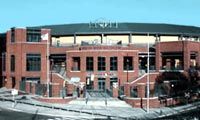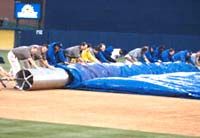The Life of a Minor League Ballplayer
The life of a minor league baseball player revolves around practice, games, meals, sleep and travel. It's a scramble to make time for their families or for other interests. In the case of the Bulls, Birling and his staff have arranged for most of the players and their families to live in the same apartment complex during the season. That way, they can share rides, and families can provide support systems for each other when the players are on the road.
Most wives don't try to work regular jobs during the season -- both because of their husbands' erratic schedules and because they're usually only in town for the season, returning to their homes in other states until spring training rolls around again.
Advertisement
For practical and team-building reasons, each baseball team travels together (on buses or planes) to away games. Every baseball organization has a different attitude towards families; some encourage wives to travel to away games, while others consider families distracting and prefer that they stay home -- or, if they come to away games, at least stay in a different hotel!
According to Crichton, Durham Bulls' CEO and president (Jim) Goodmon extends the family-friendly atmosphere at the ballpark to players and their families as well. In addition to having players meet the public and booster club members and sponsors, the Bulls also organize team gatherings and socials. And main office staff try to act as a resource for the kinds of questions new arrivals might have about the community.
One special event that was particularly successful last season will be repeated this year: Players' wives will don their husbands' uniforms and run a silent auction of baseball memorabilia on the concourse. (The benefits go to the Durham Bulls Youth Athletic League, a collaboration between the city Parks and Recreation Department and the Bulls. In this program, children from disadvantaged backgrounds are brought together for soccer and baseball. These kids are recognized on a special night each season, when they are able to hang out with the players and other Bulls' staff.)
Working at the Ballpark
Crichton, who works at marketing the team year-round, represents dozens of local young people who -- once baseball season starts -- work as many hours as the players. "A lot of people talk to me about how glamorous my job must be. And I do love it -- but they're not thinking about the fact that, on game days, we may be here 20 hours before we can go home. Then we get up and do it again the next day," he said. "We do it because we love it and we want to do a good job, but it's also a difficult time in terms of relationships in our lives and other interests."
Also a fixture at the DBAP is head groundskeeper Kevin Robinson. Robinson, who studied agronomy with a specialization in turfgrass management at North Carolina State University, may not be well known to baseball fans, but his work speaks for itself and makes him popular with the players. "The condition of the field greatly affects the game. The main goal of my job is to create a safe field, where injuries are not caused by the playing surface, and a good playing field. Communication with the players is very important -- they let me know how they like the field and I do my best to accommodate them," he said.
Robinson works on the ball field year-round. Obviously, things intensify when the season begins each spring. On those days, he's at the park by 6 a.m. or so, doing maintenance on the field, making some last minute improvements after practice and just before game time and usually wrapping up -- on a good day -- at around midnight.
DBAP ranks among Baseball America's list of the top five minor league ballparks in the country. What makes a good park? Its "play-ability," Robinson said. The process of reaching maximum "play-ability" (meaning that when a ball hits the infield, it has a "good roll" on it and takes no "bad hops") as well as creating an aesthetically pleasing park is complex and time-consuming.

For example, the correct turfgrass species for the appropriate region of the country must be determined. The DBAP has Bermuda 419 and Robinson overseeds it every fall with a perennial ryegrass to maintain a green, well manicured field year-round. The trick, he said, is a smooth transition from the ryegrass, which dies out in early summer, to the Bermuda grass, which comes out of dormancy at about the same time.
And speaking of grass: Have you ever noticed the patterns of light and dark stripes in the grass on the baseball field? Robinson explained that the effect is actually caused by the combination of a reel mower with rollers laying the grass in different directions and the reflection of sunlight off the blades of grass. "Where the pattern is a lighter shade of green, sunlight is reflecting off the leaf blade surface," he said. "Where it's darker green, the sunlight is reflecting off only the tips of the leaf blades."
Underneath the grass is a custom-designed system called Prescription Athletic Turf (PAT). This system (tailored to each park's soil, field layout, existing materials, etc.) provides maximum drainage by using 100 percent sand as the subsoil; this helps to decrease the number of rain-outs. "It eliminates some problems but creates others and makes the entire turfgrass system more delicate and harder to maintain," Robinson said. "The nutrients and water needed by the plants are not held by the sand -- they leach through the soil profile. But if you save games that would have otherwise been cancelled, it is worth it."
One of the most difficult aspects of caring for the baseball field is dealing with rain. When it becomes clear that rain is going to threaten the completion of a game, Robinson, his crew and about 15 other front-office employees pull out the "tarp." The unfolding of this heavy 170 foot by 170 foot vinyl tarp is, in itself, quite a spectacle. There's a trick to unrolling the heavy tarp smoothly without getting caught under it and being buried by your fellow rollers, he grinned.
If you would like to learn more about minor league play or locate the minor league baseball team nearest you, check out the official site of Minor League Baseball! And if you're lucky enough to have a minor league team in your hometown, go out, soak up the atmosphere and support the team -- they may be the major league stars of the future!
For much more information, check out the links below.
Related HowStuffWorks Articles
- In baseball, how does a pitcher throw a curveball?
- How does a "perfect game" in baseball work?
- How do they create patterns in a baseball field?
- When a baseball player hits a home run, how do they know how far the ball traveled?
- How do retractable roofs in convertible stadiums work?
- How Performance-Enhancing Drugs Work
More Great Links
- Durham Bulls
- Tampa Bay Devil Rays
- Minor League Baseball/Official Site
- Baseball Almanac
- The National Baseball Hall of Fame and Museum
- Baseball America
- SportingNews.com
- ESPN.com: Tampa Bay Devil Rays
- CNN/Sports Illustrated
- BaseballParks.com
- Organized Baseball Tours
- Why Is Baseball So Much Better Than Football?
- MinorLeagueBallparks.com
